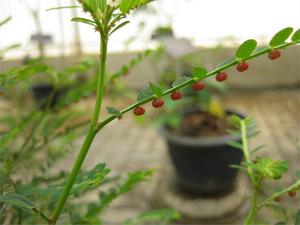
Latin: Phyllanthus Urinaria (common names: Phyllanthus Amarus, Phyllanthus Niruri)
Pinyin: Zhen Zhu Cao
Family
Physical Characteristics*
Phyllanthus is an herb that grows in remote Asian tropical, sea breeze type climates especially in the Indonesian islands as well as central and southern India. It can grow to 30-60 cm in height and blooms with many yellow flowers. All parts of the plant are employed therapeutically. Phyllanthus species are also found in other countries, including China (e.g., Phyllanthus urinaria), the Philippines, Cuba, Nigeria, and Guam.[1]
Other similar species are Phyllanthus amarus and Phyllanthus niruri. The difference between Phyllanthus urinaria and p. amarus or p. niruri is that the urinaria has larger leaves than the latter and the fruit of p. urinaria is wart-like.
Traditional Chinese Medicinal (TCM) Uses*
Phyllanthus has been used for generations in China to promote healthy elimination of gallstones and kidney stones, as an immune system stimulator and for those with liver disease. In TCM, practitioners use this herb, with its ?cool? nature, to clear dampness, heat and toxicity. Phyllanthus urinaria primarily contains lignans (e.g. phyllanthine and hypophyllanthine), gallic acid, alkaloids, and bioflavonoids (e.g. quercetin). While it remains unknown as to which of these substances has an antiviral effect, researchers believe that this herb acts primarily on the liver.*
Research in China has shown that Phyllanthus has been shown to block DNA polymerase, which is the enzyme needed for the hepatitis B virus to reproduce. In one 30 day study, 59% of those infected with chronic viral hepatitis B lost one of the major blood markers of HBV infection (e.g. hepatitis B surface antigen) after using phyllanthus.[2] While clinical studies on the outcome of phyllanthus and HBV have been mixed, the species P. urinaria and P. niruri seem to work better than P. amarus.[3]*
Other research has revealed other possible benefits like helping to soothe the liver, detoxification of the liver and kidneys, relief from pain and inflammation, reducing oxidative stress, and an ability to inhibit hepatitis B virus DNA replication. [4,5]*
It is believed that the possible benefit that phyllanthus urinaria provides in cases of liver damage could be due to the plants anti-viral activity.*
Additional Info: in Ayurvedic medicine, Phyllanthus has been used for over 2000 years in India for many medicinal uses for those with liver disease including hepatitis.*
Channel of Meridians: Lungs and liver
Sources:
1. Bharatiya VB. Selected Medicinal Plants of India. Bombay: Tata Press, 1992, pp.235-7
2. Thyagarajan SP, Subramanian S, Thirunalasundar T, et al. Effect of Phyllanthus amarus on chronic carriers of hepatitis B virus. Lancet 1988: ii: pp.764-6
3. Meixa W, Haowei C, Yanjin L, et al. Herbs of the genus Phyllanthus in the treatment of chronic hepatitis B: observation with three preparations from different geographic sites. J Lab Clin Med 1995;126: pp.350-2
4. The inhibitory effect of Chinese herb Phyllanthus on hepatitis B virus in vitro. ByZhonghua Shi Yan He Lin Chuang, pages 282-285, Sep 11, 1997 by Liu Zhuang, Fu XiXian, Zhang NaiLin, First Teaching Hospital, Beijing Medical University, 100034, China. ISSN: 1003-9279
5. Phyllanthus Urinaria Ameliorates the Severity of Nutritional Steatohepatitis Both In Vitro and In Vivo. By Bo Shen, Jun Yu, Shiyan Wang, Chu Eagle S. H., Wong V.W.S., Xin Zhou, Ge Lin, Sung Joseph, Chan Henry. Sep. 10, 2007, Hepatology ISSN 0270-9139
Research Abstracts:
http://www.ncbi.nlm.nih.gov/pubmed/18157836
http://www.ncbi.nlm.nih.gov/pubmed/17661333
http://www.ncbi.nlm.nih.gov/pubmed/15617349?dopt=Abstract
Natural dietary supplements are designed to offer the body support to promote health, harmony, balance and overall well being.*

 Get Well Natural, LLC
Get Well Natural, LLC  Kidney Function & Regeneration Health
Kidney Function & Regeneration Health  Platelet & Blood Cell Health
Platelet & Blood Cell Health  Prostate, Flow & Function Health
Prostate, Flow & Function Health  General Mind & Body Health
General Mind & Body Health  Heart, Cholesterol & Cardio Health
Heart, Cholesterol & Cardio Health  Allergy-Free Body
Allergy-Free Body  Anxiety & Stress
Anxiety & Stress  Blood Platelet Counts & Function
Blood Platelet Counts & Function  Blood Pressure Health
Blood Pressure Health  Kidney Health
Kidney Health  Immune System Health & Balance
Immune System Health & Balance  Prostate & Urinary Health Function
Prostate & Urinary Health Function  Blood Sugar Balance
Blood Sugar Balance  Cardiovascular Heart Health
Cardiovascular Heart Health  Detoxification & Healthy Cells
Detoxification & Healthy Cells  Women's Health
Women's Health  Liver Regeneration
Liver Regeneration  Pain-Free Body
Pain-Free Body  Water & Air Filtration
Water & Air Filtration 


